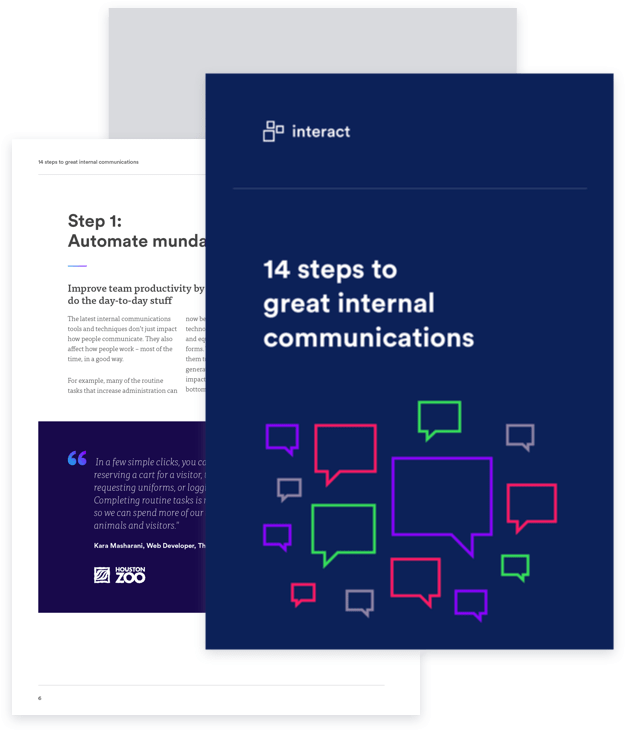The anatomy of great internal comms: creating compelling IC campaigns

Much like the human body, your internal comms needs a combination of strong individual parts to function successfully. The result of these effective and cohesive parts are compelling IC campaigns that engage and fascinate your staff.
The significance of effective IC is recognized by organizations around the world, regardless of industry. Its proven effects on a company’s bottom line are enough to encourage any IC professional to evaluate, design and deploy first-rate IC campaigns.
But one cannot step into this process unprepared. Determining the proper method is almost like surgery – needing many predetermined parts to come together into one complete product. Without all the pieces, your IC project may end as a failure.

Here, we’ll break down the IC practices that make up the brain, heart, body, and blood of a great internal comms campaign.
Download the Interact Excellence Awards Annual 2019 today
If your goal is to increase employee engagement with compelling IC, there’s no better way than to see an example of IC campaigns gone right. Our award-winning intranets demonstrate internal comms that manage to combine technology, comms best practices, and strategic vision into engaging internal comms for an entire workforce.
So, whether it’s sending off communications to select employees, or implementing a company-wide communications campaign, these IC practices will help you develop your own strategy for obtaining great internal comms.
The Brain
At the head of every successful IC campaign are the individuals that band together to map out, define and implement a winning blueprint. Much like the brain, every distinct IC strategy must be tailored to the respective organization. What may work for one company can be detrimental to the next. It is up to the leaders and executives of the organization to steer their internal comms in the right direction. Below are some elements crucial to an effective IC campaign:
Define your IC strategy
The first step to any plan is to build a strategy. Attempting any large exploit without proper planning can lead to numerous mistakes as the campaign process moves further along.
Ensuring the foundation of your IC project is sound creates a framework that will eventually lead your IC campaigns toward success. Leaders should establish collective responsibility across the entire organization, clear goal setting, methods for managing expectations, and defined roles and responsibilities.
The critical element to success is setting benchmarks. These benchmarks should follow the objectives set and agreed upon by the company executives.
Discuss what you want to achieve, how it will be performed, the schedule and how you’ll measure the results. Consider any organizational changes that might need to be made to promote the necessary change and spur an increase in engagement.
It is important that you include C-level leaders as well as important stakeholders you can rely on to help provide content, manage distribution, and more.
Storytelling and transparency
Humans are hard-wired for stories. We absorb information better when it is less of a lecture and more a narrative that appeals to the human element within us all. Organizations across the world have successfully utilized this psychological connection in their marketing and IC campaigns.
Among all the figures of business, what’s often lost is the human element. Stories create this effect, leaving individuals with something to remember and value.
Incorporating stories into your messages and content can create a shared sense of identity or transmission of values and motivation. Foreign exchange and payment solutions multi-national provider, Travelex, does a great job letting their leaders pave the way with their “5 minutes with…” intranet campaign.

These popular monthly vlogs from senior management are where colleagues can pose questions for the nominated leader to answer. Stakeholders’ blogging activity – from their introductions to weekly round-ups – has become so central to ‘The Lounge’, that an average of eleven new blogs spring up each day. Thanks to the contributions put forward by top management and the stakeholders at Travelex, their accessibility as people and their capability as leaders have only improved.
Once users see their seniors embrace blogging as another form of communication, they are more inclined to bring forward their own stories and connect to organizational goals.
The Heart
Employees always have been and always will be the heart of any organization. Without the backing of your employees (the very people you are hoping to engage), your organization is only operating at half of its strength. Instead of focusing solely on the needs of your leaders and stakeholders make your staff a priority. Seeing your IC strategy from their perspective will guarantee more success and engagement than any other method.
Two-way communication
Listen. Listen. Listen. No IC campaign can succeed without first hearing, understanding, and addressing the needs of the staff. To create and execute a strategy without first establishing what will best support your employees is like attempting surgery without first reading the patient chart.
The best way to ensure your employees are being supported is to give every individual a voice.
Open up the room for discussion – or rather, open up your intranet. Your intranet can be the perfect tool for collaboration.
Employee-generated content
56% of communicators still struggle to keep employees engaged and informed. It’s time to consider your content. The value of generating quality content that stands out from the rest cannot be underestimated. So, consider your blog, intranet homepages, social posts, and more. Does it address the challenges and needs of your audience?
Though you may not currently be utilizing them, you have a powerful internal comms tool available: your employees.
Long-standing Interact customer, Midland Heart has seen success with positive strides to get more user-generated content.
The most significant barrier facing Midland Heart was staff apprehension. Users were hesitant to share personal stories or experiences on the intranet. To help others overcome their fear of contributing, someone needed to go first. Two members of the Equality and Diversity Program Board volunteered.

These leaders chose to share highly personal blogs during awareness campaigns. The first shared his experiences in life and work as a gay man. The second was a manager who shared her battle with mental health and the story behind her recovery process.
Both blogs gained massive support from across the organization, breaking down barriers and setting new engagement highs.
Their leap of faith has empowered staff to use their own voices to write their own blogs. With this, members feel listened to, valued, and recognized.
Body
If your employees represent the heart, then the body is represented by the teams and departments that make up your organization. These people are the limbs that carry your plans and goals forward, and as such must act as one cohesive unit to make any real progress toward success. While teams are often distributed across time zones and locations, seamless collaboration is the real key to engaging your staff no matter where they are based.
Offline Strategy
Your offline workersare crucial to your company, often the face of your locations and remote initiatives. However, they are usually a company’s most neglected employees.
Individuals that are so important to your organization should be treated as such. Without a proper strategy, your departments can fall apart, separating into silos that suffer from difficulties connecting with other staff and transporting and sharing necessary information.
Acadian Companies, the largest and most respected privately held medical transportation company in the US, tackled this problem head-on with their intranet ‘Acadian Central.’

The team created customized homepages for each division, an act that required a deep understanding of their unique needs and challenges. Homepage news feeds were also heavily targeted to ensure content was relevant to the division while also alleviating unnecessary content and links
Acadian has since seen a 550% increase in views of the division homepage, users now spending one-and-a-half minutes more on pages each session. This shows that employees are not only viewing the content but actually spending time reading over the added articles and documents. Focusing on departmental needs was necessary to get every facet of the organization on the same page.
14 steps to great internal communications
Engage with video
56% of communicators still struggle to keep employees engaged and informed. Luckily, we now know that 60% of people prefer video over reading text– and organizations in every industry are taking advantage. No matter how important the information may be, if it isn’t packaged correctly, no one will receive it. Is video the answer?
Organizations are now concluding that vlogs and videos made on mobile phones or posted to the company intranet are popular among staff. Wheatley Group, winner of the Best Video Award in Interact’s Excellence Awards 2019, noticed an increased appetite for video content and delivered.

The department aimed to produce bite-sized video content that could quickly tell stories from across the organization and highlight work done by different teams. The communications team created mobile videos to complement photography and written news, report on visits made by politicians to Wheatley projects and convey key messages relating to the industry.
Since embracing video, their views are in the thousands, an upgrade from average blog posts that attract around 100 hits.
The Blood
Once you adapt your approach to include these practices and techniques, the quality and scale in which staff engages with your content will steadily increase. The body cannot be fully functional with just the body parts. Having blooding running through your veins is what keeps the body alive, operative, and moving. The same must go for your IC campaigns.
While you have pieced together the necessary parts to get your campaigns started, analytics are required to keep things pumping. The process does not end with the campaign launch. Keep an eye on things going forward to secure the effectivity of your internal communications.


